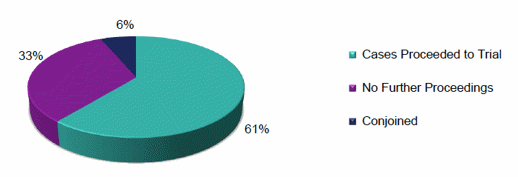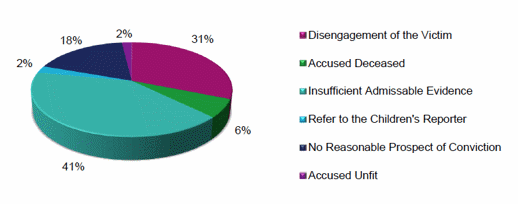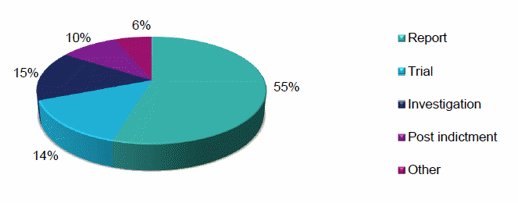Related Downloads
Additional
Chapter 1 – Outcome Of High Court Sexual Crimes
1. We examined all cases reported by the police in 2014-15 where an accused appeared in court on a charge of a sexual crime and the case was identified as a potential High Court case. [17] There were 643 such cases, of which 4 are still active.
Outcome of Cases
2. Of the 639 concluded cases, 61% (391) proceeded to trial, 33% (207) were discontinued by the prosecution and recorded as no further proceedings and 6% (41) were conjoined [18] into another case involving the same accused. [19]
Chart 1 - Sexual Offences Outcomes 2014/15

Outcome of Trial Proceedings
3. Chart 2 provides a breakdown of the outcome of the 391 cases that proceeded to trial. [20] Of these, 65% (254) resulted in a finding of guilty [21] or a guilty plea. A finding of not guilty [22] or a not guilty plea was accepted in 29% (114) and in the remaining 6% (22) there was a finding by the court that there was insufficient evidence at the end of the prosecution case (a finding of no case to answer) or the case was discontinued by the court (deserted simpliciter) (1).
Chart 2 - Cases Proceeding to Trial

Discontinued Cases
4. We examined the 207 cases that were discontinued by the prosecutor after the accused had appeared on petition. Chart 3 illustrates the substantive reason for the case not proceeding. The three main reasons were: insufficient admissible evidence in 41% (85), disengagement of victims’ in 31% (66), and no realistic prospect of conviction in 18% (37). In the remaining cases, five were referred to the Scottish Children’s Reporter, in 13 the accused died during the course of the proceedings and in one the accused was deemed unfit for trial.
Chart 3 - Reason for No Further Proceeding Decision

Stage of Proceedings where Cases Discontinued
5. Chart 4 provides an overview of the stage of proceedings where the cases were discontinued.
Chart 4 - Stage of 'No Further Proceeding' Decision

Of the 207 cases:
- In 15% (31) a decision was taken not to continue with the prosecution during the initial investigation undertaken by specialist sexual crime teams;
- More than half – 55% (113) – were discontinued after the case was reported to NSCU for a decision on whether there was sufficient evidence (reporting stage);
- 10% (20) were discontinued after the case had been indicted but prior to the trial;
- 14% (30) were discontinued at the trial; and
- The remaining 6% (13) did not proceed due to the death of the accused.
Discontinued Cases
Disengagement of Victims
6. Some of the 66 cases discontinued due to the disengagement of a victim, involved more than one victim, resulting in a total of 83 victims who withdrew, for a variety of reasons.
7. 18 of the 66 cases were dependent on the application of the Moorov doctrine to provide sufficient evidence. As a result of the disengagement of at least one victim, these cases could no longer proceed, resulting in the charges involving other victims having also to be discontinued.
8. 51 cases were discontinued when the case was reported to NSCU or later.
9. As the victims’ evidence is the lynchpin in the vast majority of cases involving sexual crimes, the inability in such a high proportion of cases to retain their engagement throughout the process is of concern and a significant factor in the high attrition rate of such cases.
10. We conducted further analysis of the 66 cases, involving 83 victims, to identify specific reasons for disengagement.
Analysis of Reasons for Disengagement
11. Of the 83 victims:
12. 16 victims had made it clear from the outset that they did not wish to engage with any proceedings. In the circumstances, it is not surprising that proceedings were discontinued due to the non-engagement of the victims.
13. In six of the 16 cases, the police had proactively identified a former partner or partners of the accused and obtained statements regarding similar offending. This proactive approach is adopted by officers where there is intelligence that the suspect is a serial perpetrator, often violent and presents a risk of harm to victims, their families and is likely to re-offend. It has resulted in a number of convictions of high risk offenders.
14. There is a clear public interest in apprehending such perpetrators by identifying other potential victims who, if they participate, will provide a sufficiency of evidence where there is otherwise none or strengthen an existing case. However, care requires to be taken to ensure that such victims are genuinely engaged and accept that they may be required to attend court.
15. We were advised that Police Scotland has recently issued revised guidance on the use of proactive investigation as a tactic. The guidance highlights the requirement for an open, honest and transparent approach and specifically states that:
“Officers should ensure victims have a clear understanding that any statement provided by them may form part of criminal justice proceedings and may result in a requirement for them to attend court as a witness.”
16. This refreshed guidance is to be welcomed. Our findings confirm the importance of emphasising at the outset the consequence of providing a statement. It is likely to compound the distress of the victim who made the initial allegation, with all the consequences that flow from the accused being arrested and charged, if the prosecution has later to be discontinued due to the non-engagement of another victim who was never fully engaged.
17. In the remaining cases where the victims disengaged:
- 21 who were identified as being vulnerable disengaged during the investigation stage;
- 10 who were identified as being vulnerable disengaged at court as they were physically unable to give evidence;
- 8 changed their initial account regarding an essential part of the allegation;
- 25 opted out and refused to co-operate during the course of the investigation; and
- 3 disengaged due to the length of time that the proceedings had taken stating that they just wanted to “get on with their life”.
Disengagement where Case Discontinued due to Insufficient Evidence
18. In addition to the 66 cases, there were 14 cases discontinued, due to insufficient evidence, where at least one victim had disengaged.
19. On reviewing these cases:
- 4 who were identified as being vulnerable disengaged during the investigation stage;
- 4 victims opted out and refused to co-operate during the course of the investigation;
- 3 changed their initial account regarding an essential part of the allegation;
- 2 refused to co-operate at court; and
- 1 moved overseas.
20. Thus the total number of cases where victims disengaged was 80, which was 12% of the total sample and 38% of all cases discontinued.
Post Indictment
21. We conducted further analysis of cases that were discontinued after having been indicted (50 cases) in an attempt to gain some understanding why the decision was taken at such a late stage, and after the cases had been considered on a number of occasions.
Insufficient Admissible Evidence
22. We found that 20 cases were discontinued due to insufficient evidence. [23] The cases fell into four categories:
- In 9 the evidence led at court did not meet expectation of the prosecutor resulting in there no longer being a sufficiency of evidence.
- In 4 essential evidence was no longer admissible due to new information.
- In 1 new evidence was obtained which resulted in there being insufficient evidence to proceed.
- In 1 the complainer was too distressed to give evidence.
- In 5 it was not possible from the case files to establish the reason for the late decision.
No Realistic Prospect of Conviction
23. There were 13 cases discontinued, after being indicted, because there was no longer a realistic prospect of conviction. [24]
24. Two themes were identified:
- In 10 cases, new evidence came to light which undermined the victims’ account of what happened resulting in the case being discontinued as it was considered there was no longer a realistic prospect of securing a conviction. In five of the ten cases the evidence was the result of phone analysis or from communications using social media platforms.
- In the remaining 3 cases, the quality of evidence given at the trial did not meet the expectation of the prosecutor and it was assessed that there was no longer a realistic prospect of obtaining a conviction.
Disengagement of Victims
25. 16 cases were discontinued as a result of victims disengaging from the prosecution. In 8 of these cases the prosecution was seeking to prove the case through the application of the Moorov doctrine, using the evidence of more than one victim.
Other
26. One case was discontinued due to the ill-health of the accused.
Overview
27. Of the cases that proceeded to trial, 65% either resulted in a plea or finding of guilty.
28. The main reason for the discontinuation of cases was insufficient evidence. It is a legitimate and proper function of the prosecutor to continue to review evidence throughout the life of a case and assess whether new evidence emerging, either before or during a trial, impacts on the decision to prosecute in the public interest.
29. Of more concern is the number of victims that disengaged at various stages throughout the process. 51 of the 66 cases where the victim disengaged occurred after the case had been reported to NSCU. In 16 of these an indictment had been served on the accused. This represents a significant number of victims that withdrew towards the end of the process and after considerable investigation work had been undertaken.
Key Finding
The high number of victims who disengage during the criminal justice process, after taking the significant step to report the crime, infers that more could be done by the criminal justice system, in which COPFS is arguably the key organisation, to provide the necessary information and support to victims, many of whom have complex needs or vulnerabilities, to enable them to have the confidence to continue throughout the process.
30. We examine what measures COPFS can introduce to mitigate and redress this level of disengagement in Chapter 4.
